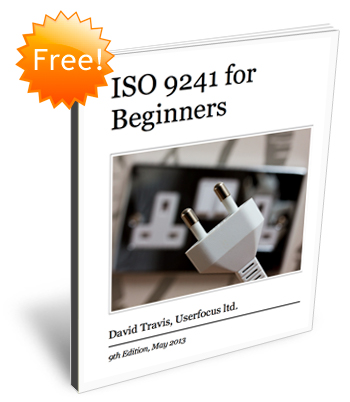UX Certification
Get hands-on practice in all the key areas of UX and prepare for the BCS Foundation Certificate.
This eBook summarises the various parts of ISO 9241, with each part of the standard described on 2-3 pages.
Download pdf version — best for printing.
Download epub version — best for iPad, iPhone and other eBook readers.
Delivery method: Free, electronic download (PDF & ePub)
98 pages, last updated October 2014.

In the dusty institutions where usability standards gather to party with each other, ISO 9241 is a bit of a celebrity.
It is widely cited by people who would be hard pushed to name any other standard, and parts of it are virtually enshrined in law in some European countries.
But as is the fate of many celebrities, all most usability professionals know about the standard is its name. This downloadable eBook describes each of the published parts of ISO 9241 in detail.
“If an organisation is modifying their web site, or considering building a new one, then the commissioner must be able to ensure that the site is a benefit to the business... I would therefore recommend reading and acting upon three documents: PAS 124, PAS 78 and David Travis's Guide to ISO 9241.” — Peter Abrahams, Practice Leader — Accessibility and Usability, Bloor Research. "Three inexpensive and essential investments for web site commissioners".
“This book is just brilliant! I admire the effort you put into it to get this information out to people. I also love your whole layout and approach. You communicated so much information on one page per document. A very high Wow! factor!”
— KM, Denmark.
The book clearly describes each part of ISO 9241 on a single page. For each part of ISO 9241 you will get answers to these common questions:
“It gives me a place to go when I need specific information. Before I wouldn't have known where to start.” — ST, USA
“I needed to quickly understand the new requirements to put together a proposal for a client. This guide fitted the bill perfectly.” — MM, Canada
“I remember feeling pretty chuffed when I chanced upon the guide — anything but have to pay through the nose for and wade through the full standard. Excellent work.” — PK, Ireland
“Everybody talks about ISO Documents, but nobody has really ever seen them. I wanted to know what I was talking about without buying (and reading) the whole stuff.” — OB, Switzerland
“I got the book because I needed to prepare a quotation response. It impressed the hell out of most and scared the rest as it made them realise how much they should have known!” — GH, Amsterdam
“It was a great help preparing my University lectures on system usability.” — PD, Italy
“Having a good summary of usability standards like this, that is easy to turn to, is invaluable. It's going to be a great help introducing my clients to the standards that drive my work.” — SC, Australia
“The free updates are great and novel! Thank you!” — PR, UK
“It has inspired me to go to the British library and look up the ISO in full, and now I feel a bit more informed about which parts to zone in on.” — JM, UK
“After reading your guide I actually bought and downloaded part 151 of ISO 9241 from the ISO web site. Your document came in useful for understanding how ISO documents are constructed.” — GP, UK
Let us help you create great customer experiences.
We run regular training courses in usability and UX.
Join our community of UX professionals who get their user experience training from Userfocus. See our curriculum.
copyright © Userfocus 2021.
Get hands-on practice in all the key areas of UX and prepare for the BCS Foundation Certificate.
We can tailor our user research and design courses to address the specific issues facing your development team.
Users don't always know what they want and their opinions can be unreliable — so we help you get behind your users' behaviour.